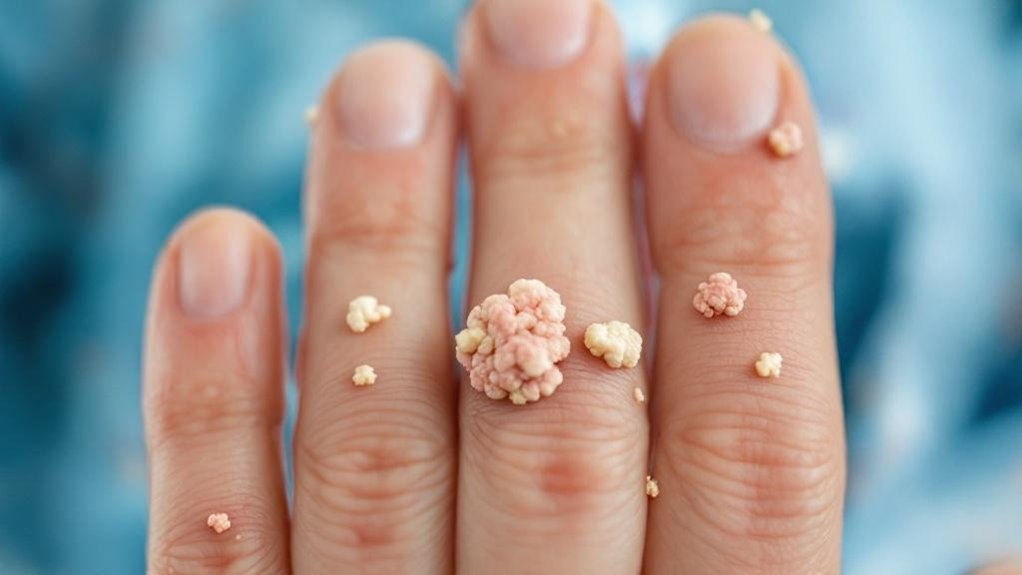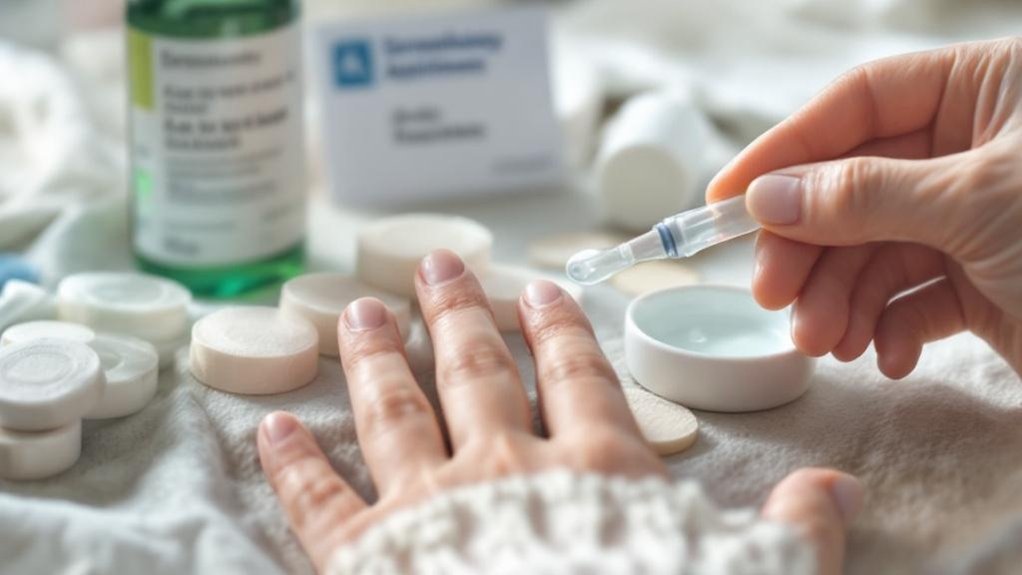Warts are common skin growths caused by human papillomavirus (HPV), appearing as rough-textured bumps on the skin. We classify them as common, plantar, flat, or filiform, depending on their location and appearance. They’re transmitted through direct contact or contaminated surfaces, with children and immunocompromised individuals at higher risk. Treatment options range from over-the-counter salicylic acid to professional cryotherapy or laser removal. Understanding your specific wart type guides ideal treatment selection.

Warts are small skin growths that are caused by a viral infection call the Human papillomavirus (HPV). There are more than 100 known types of HPV, a virus that infects the top layer of skin. Small and usually painless, warts tend to be more
embarrassing than dangerous. Warts are usually rough and skin-colored depending on the HPV strain and the part of the body affected. However, they can be flat, dark and smooth. They are not usually cancerous. HPV causes the top layer of skin to grow at a rapid pace. The result is a wart. Typically these warts will go away on their own in a few months or a few years.

Warts manifest as benign epidermal growths caused by various strains of the human papillomavirus (HPV). Though often misunderstood, these lesions aren’t caused by touching frogs or other common misconceptions. Instead, they spread through direct contact with infected individuals or contaminated surfaces.
We classify wart varieties based on their appearance and location. Common warts (verruca vulgaris) typically appear on hands and fingers as rough, raised growths. Plantar warts develop on pressure points of the feet, while flat warts present as smooth, flat-topped lesions often found on the face or legs.
Filiform warts appear thread-like, primarily affecting the face, and genital warts occur in the anogenital region. Each type corresponds to different HPV strains, with over 100 identified variants capable of infecting human skin.
Because HPV thrives in warm, moist environments, viral transmission typically occurs through direct skin-to-skin contact or indirect contact with contaminated surfaces. Wart transmission is particularly common in communal areas like swimming pools, locker rooms, and shared showers where the virus can survive on wet surfaces.
Several risk factors increase susceptibility to warts. These include:
We observe that children, teenagers, and immunosuppressed individuals have higher incidence rates due to their immune response profiles.
Remember that incubation periods vary from weeks to months, making infection source identification challenging in many cases.

While most cutaneous growths appear as small, flesh-colored bumps, warts exhibit distinctive characteristics that aid in clinical identification.
We commonly observe rough, grainy textures with pinpoint black dots (thrombosed capillaries) and potential pain when pressed. Patients often experience wart anxiety due to visible symptoms on hands, feet, or genitalia.
Contrary to popular wart myths, these lesions don’t always require immediate treatment. However, we advise medical consultation when warts:
Early evaluation helps prevent spreading and guarantees appropriate treatment selection for your specific wart presentation.
Treatment of cutaneous warts involves a multi-faceted approach ranging from conservative home-based therapies to advanced dermatological interventions.
For minor warts, home remedies such as salicylic acid preparations, duct tape occlusion, and apple cider vinegar may provide benefit, though evidence varies regarding efficacy.
When self-care proves insufficient, we recommend professional medical treatments. These include cryotherapy (freezing with liquid nitrogen), electrodesiccation, laser therapy, and chemical cautery. For recalcitrant or extensive warts, immunotherapy may be employed to stimulate the body’s immune response against the virus.
The selection of appropriate intervention depends on wart location, patient age, pain tolerance, and previous treatment response. We tailor each treatment plan to your specific needs, considering both therapeutic effectiveness and your comfort throughout the process.

Prevention of warts requires proactive measures and understanding of human papillomavirus transmission pathways.
We recommend maintaining intact skin barriers through regular moisturizing and prompt treatment of cuts or abrasions, which helps minimize viral entry points.
In communal spaces like pools and locker rooms, we advise wearing protective footwear to reduce plantar wart transmission risk. Several lifestyle adjustments can support long-term management. Boost immunity through adequate sleep, balanced nutrition, and stress reduction techniques.
Some patients find value in natural remedies like tea tree oil or apple cider vinegar applications, though clinical evidence remains limited. For recurrent cases, we implement periodic cryotherapy or chemical treatments as prophylactic measures. Remember that wart prevention necessitates consistency—regular hand washing, avoiding sharing personal items, and maintaining healthy skin are your best defenses.
Yes, warts are contagious in pools. We recommend awareness of warts transmission through direct contact with infected surfaces. Practicing good swimming hygiene helps prevent spreading these viral lesions among our community.
While we can’t recommend nail polish during active periungual wart treatment, it may impede medication absorption and proper nail hygiene. We’ll work with you to develop an appropriate treatment schedule that accommodates your needs.
Most wart removal methods can leave scars, but we employ techniques to minimize scarring. We’ll discuss scar prevention options during your consultation and recommend post-treatment care for ideal healing.
Yes, stress can impact your immune response, potentially allowing HPV to flourish. We’ve observed that stress management is an important component in preventing wart development and limiting spread in our patients.
We approach wart treatment during pregnancy with caution. Certain therapies are contraindicated due to potential pregnancy complications. We’ll employ safer options while monitoring both maternal and fetal well-being throughout treatment.
We’ve examined various wart types, their viral etiology, transmission mechanisms, and clinical presentations. Our institute offers a thorough treatment algorithm ranging from conservative topical therapies to advanced destructive modalities. Patient-specific factors—including wart morphology, anatomical location, and immunologic status—guide our therapeutic approach. While recurrence rates remain significant (20-30%), adherence to preventive measures substantially reduces transmission risk. Schedule evaluation if you’re experiencing persistent or multiplying lesions.